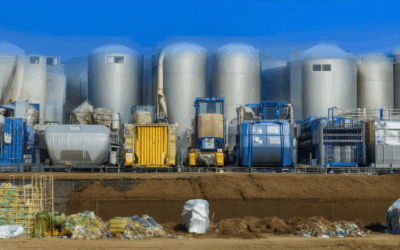Carbon-positive waste systems are revolutionizing how organizations manage their waste, offering a pathway to both environmental excellence and operational efficiency. By integrating innovative strategies that minimize carbon emissions and maximize resource recovery, these systems not only reduce ecological impact but also align with global sustainability goals. Businesses are increasingly adopting carbon-positive approaches, which involve reducing waste sent to landfills and enhancing recycling rates, often complemented by carbon offset programs for unavoidable emissions. This shift not only addresses environmental concerns but also fosters a culture of sustainability within organizations, appealing to eco-conscious consumers and stakeholders. The implementation of such systems requires careful consideration of sustainable material selection, advanced waste sorting technologies, and circular economy principles to ensure effectiveness. Moreover, the adoption of carbon-positive waste systems leads to tangible benefits, including cost savings from reduced disposal expenses and strengthened brand loyalty due to a commitment to environmental stewardship. As industries strive to meet growing demands for sustainable practices, embracing carbon-positive waste systems emerges as a cornerstone of modern, responsible operations.
Key Takeaways
– Reduced Landfill Dependency: Carbon-positive waste systems cut down on methane emissions by diverting waste from landfills, a major contributor to U.S. methane emissions.
– Generates Renewable Energy: These systems often produce biogas through anaerobic digestion, which can be used as a renewable energy source, reducing reliance on fossil fuels.
– Enhances Soil Fertility: Biochar, produced from waste, acts as a natural fertilizer, improving soil health, retaining moisture, and promoting sustainable agriculture.
– Promotes Circular Economy: By optimizing resource reuse, these systems align with circular economy principles, reducing waste and environmental impact.
– Contributes to Carbon Sequestration: Biochar production supports carbon storage in soil, aiding in climate change mitigation and creating carbon sinks.
– Cost Savings: Organizations save money by reducing landfill use and implementing recycling and composting programs, lowering tipping fees and material costs.
– Environmental Impact Reduction: Carbon-positive methods significantly lower carbon emissions, with composting reducing methane production and energy recovery systems generating renewable energy.
– Regulatory Compliance and Brand Reputation: Aligning with sustainability goals enhances regulatory adherence and builds a positive brand image, fostering stakeholder trust.
– Resource Efficiency: These systems recover valuable nutrients and energy, supporting resource circularity and reducing the need for raw material extraction.
– Community Engagement: Programs like zero-waste initiatives foster collaboration with local governments and NGOs, driving social responsibility.
– Innovation and Market Differentiation: Early adoption positions organizations as sustainability leaders, attracting investments and partnerships, while driving technological advancements.

What Makes a Waste System Carbon-Positive?
A waste system is considered carbon-positive when its operations and outcomes result in a net removal of carbon dioxide from the atmosphere. This occurs through several key mechanisms:
- Methane Capture : Many waste systems emit methane, particularly from organic waste decomposition in landfills. By implementing anaerobic digestion or composting, methane can be captured and utilized as renewable energy, preventing its release into the atmosphere.
- Reduced Environmental Impact : Efficient waste management minimizes the environmental footprint. Reducing landfill use and promoting recycling and reuse lowers energy consumption, decreases emissions associated with raw material extraction, and minimizes leachate leakage.
- Carbon Sequestration : Technologies like pyrolysis convert organic waste into biochar, a carbon-rich material that can be used as a soil amendment. This biochar acts as a long-term carbon sink, storing carbon in the ground and contributing to carbon sequestration efforts.
- Circular Economy Promotion : A carbon-positive waste system aligns with the circular economy by treating waste as a resource. Initiatives like zero-waste programs and closed-loop systems ensure materials are maximally reused, reducing the demand for energy-intensive production processes.
- Clean Water Treatment : Effective wastewater treatment prevents contamination of water bodies, preserving ecosystems and indirectly supporting carbon reduction by maintaining biodiversity and reducing pollution-related energy use.
By integrating these strategies, a waste system can become a significant contributor to carbon removal, demonstrating its role in combating climate change while promoting sustainable practices.
How Can Businesses Implement Carbon-Positive Waste Systems?
To implement a carbon-positive waste system, businesses should focus on transforming waste into valuable resources while offsetting their carbon footprint. Here’s a structured approach:
1. Assess Current Waste Streams
- Identify organic, recyclable, and non-recyclable waste to tailor strategies.
- Conduct a waste audit to understand volume and type, aiding in system design.
2. Invest in Sustainable Technology
- Adopt technologies like composting, pyrolysis, or anaerobic digestion.
- Consider partnerships with companies specializing in waste-to-resource solutions.
3. Train Employees and Stakeholders
- Provide education on waste management practices and sustainability goals.
- Offer workshops or resources to foster a culture of environmental responsibility.
4. Set Clear Goals and Metrics
- Define measurable objectives, such as reducing landfill waste or increasing resource recovery.
- Track progress through metrics like waste diversion rates and carbon savings.
5. Foster Partnerships and Collaborations
- Work with local governments, NGOs, and other businesses for shared learning and resource sharing.
- Explore public-private partnerships to scale initiatives effectively.
6. Promote Circular Economy Practices
- Design products for longevity and repairability to minimize waste generation.
- Engage in product take-back programs to keep materials in the economy.
7. Offset Carbon Footprint
- Calculate the carbon impact of waste operations and offset it through verified projects.
- Seek certifications like Carbon Neutral or Zero Waste to demonstrate commitment.
By integrating these strategies, businesses can create a carbon-positive waste system that aligns with their sustainability goals and contributes positively to the environment.

Essential Elements of a Carbon-Positive Waste System
A carbon-positive waste system is designed to not only manage waste effectively but also contribute positively to the environment by reducing its carbon footprint. Here are the key components that make such a system successful:
- Reducing Landfill Dependency
Effective waste systems prioritize reducing the amount of waste sent to landfills. This is achieved through robust recycling and composting programs. Recycling diverts materials from landfills, while composting turns organic waste into nutrient-rich soil, reducing the need for synthetic fertilizers and lowering carbon emissions. - Renewable Energy Integration
Carbon-positive systems often incorporate renewable energy sources to power waste processing facilities. Solar panels, wind turbines, and biogas plants can provide clean energy, further reducing the carbon footprint associated with waste management operations. - Circular Economy Principles
Embracing circular economy practices ensures that waste is seen as a resource rather than a problem. This involves designing products for durability, repairability, and recyclability, reducing the overall demand for new materials and thus lowering carbon emissions from production processes. - Waste-to-Energy Technologies
Advanced waste-to-energy technologies, such as incineration and anaerobic digestion, convert non-recyclable waste into energy. These methods not only generate electricity but also produce biochar, a carbon-rich material that can sequester carbon and improve soil health. - Carbon Offset Programs
While efforts are made to minimize carbon emissions, unavoidable emissions can be offset through carbon offset programs. These programs support projects that reduce greenhouse gas emissions, such as reforestation or renewable energy installations, balancing out the environmental impact of waste operations. - Community Engagement and Education
Successful carbon-positive waste systems rely on community involvement. Educating residents about waste reduction, recycling, and composting behaviors can significantly lower the environmental impact. Public-private partnerships and awareness campaigns play a crucial role in achieving these goals.
By integrating these elements, a carbon-positive waste system can become a powerful tool in combating climate change while promoting sustainable practices. Organizations like Pyrolysium are at the forefront of innovation, pioneering technologies and strategies that align with these principles to create a more sustainable future.

Environmental Benefits of Carbon-Positive Waste Systems
Implementing carbon-positive waste systems offers numerous environmental benefits, contributing significantly to sustainability and ecological health. Here’s a breakdown of the key advantages:
- Reduced Landfill Dependency: By diverting waste from landfills, these systems decrease methane emissions, a potent greenhouse gas. Methane released from decomposing waste in landfills accounts for a significant portion of U.S. methane emissions.
- Emissions Reduction: Carbon-positive systems often generate renewable energy through processes like anaerobic digestion or pyrolysis. This energy can power waste facilities, offsetting their carbon footprint and reducing overall emissions associated with traditional waste management practices.
- Resource Recovery: These systems extract valuable materials from waste, such as organic matter, metals, and plastics. This reduces the need for raw material extraction, conserving natural resources and minimizing environmental degradation associated with mining and manufacturing.
- Soil Enhancement and Biodiversity Support: Products like biochar, derived from waste through pyrolysis, improve soil fertility, enhance carbon sequestration, and promote biodiversity. This creates a positive feedback loop where waste becomes a resource for sustainable agricultural practices.
- Water Conservation: Closed-loop systems designed for waste processing often reuse water, minimizing freshwater intake and reducing wastewater discharge. This helps protect local water ecosystems and ensures efficient resource utilization.
- Circular Economy Promotion: By keeping materials in use for as long as possible, carbon-positive waste systems align with circular economy principles. This reduces the demand for new resources and decreases pollution from extraction and production processes.
These benefits collectively contribute to a more sustainable future, demonstrating the potential of carbon-positive waste systems to drive environmental and societal progress.
Measurable Benefits of Adopting Carbon-Positive Waste Systems
Adopting carbon-positive waste systems offers numerous tangible benefits to organizations, contributing to operational efficiency, environmental stewardship, and long-term sustainability. Here are the key measurable advantages:
- Cost Savings:** Organizations reduce their reliance on costly landfill disposal by implementing recycling, composting, and waste-to-energy programs. Lower tipping fees and reduced material costs contribute to significant financial savings annually.
- Environmental Impact Reduction:** By managing waste through carbon-positive methods, organizations significantly lower their carbon emissions. Composting diverts organic waste from landfills, preventing methane production, while energy recovery systems generate renewable energy, offsetting fossil fuel use.
- Regulatory Compliance and Brand Reputation:** Aligning with sustainability goals enhances compliance with environmental regulations and strengthens an organization’s commitment to ethical practices. This fosters trust among stakeholders, including customers and investors, who value eco-conscious businesses.
- Resource Efficiency:** Carbon-positive waste systems enable the recovery of valuable resources such as nutrients and energy. This supports resource circularity, reducing the need for raw material extraction and lowering production costs associated with sourcing new materials.
- Community Engagement:** Initiatives like zero-waste programs and public composting centers foster collaboration with local governments and NGOs, enhancing community involvement and social responsibility.
- Innovation and Market Differentiation:** Early adoption positions organizations as leaders in sustainability, attracting investment and partnerships. It also drives technological innovation, as companies seek to optimize waste management practices and integrate advanced solutions.

What Are the Key Benefits of Implementing Carbon-Positive Waste Systems?
1. Reducing Landfill Dependency
Carbon-positive waste systems help reduce reliance on traditional landfills, which are major contributors to methane emissions and environmental degradation. By diverting organic waste from landfills, these systems minimize harmful greenhouse gas production while promoting sustainable resource management.
2. Generating Renewable Energy
Many carbon-positive waste systems produce biogas through anaerobic digestion, which can be harvested as renewable energy. This dual benefit of waste conversion and energy generation supports sustainability goals while reducing dependence on fossil fuels.
3. Enhancing Soil Fertility
Biochar, a product of certain waste-to-resource processes, acts as a natural fertilizer, improving soil health and crop yields. Its ability to retain moisture and nutrients makes it an invaluable tool for sustainable agriculture, helping to combat desertification and promote food security.
4. Promoting Circular Economy Principles
Carbon-positive waste systems align with the circular economy by minimizing waste and maximizing resource reuse. This shift encourages businesses and communities to adopt more sustainable practices, reducing their environmental footprint and fostering innovation.
5. Contributing to Carbon Sequestration
Some waste systems, particularly those involving biochar production, sequester carbon in the soil. This carbon storage contributes to combating climate change by mitigating greenhouse gas emissions and supporting carbon sinks.
Conclusion
Implementing carbon-positive waste systems offers a holistic approach to environmental sustainability, addressing waste management, energy production, and climate change mitigation. By adopting these systems, we can create a more sustainable future while benefiting from their numerous advantages.




0 Comments